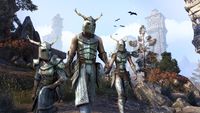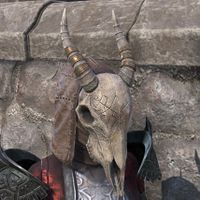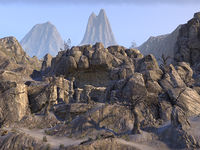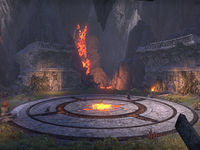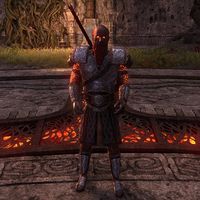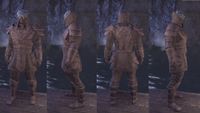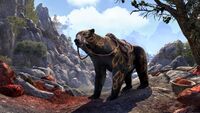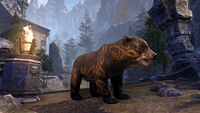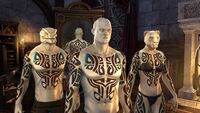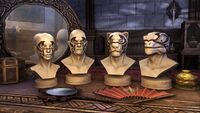Lore:Keptu
The Ket Keptu, or simply Keptu,[1] were an ancient race of Men native to central Hammerfell[2] and the hinterlands bordering Cyrod and Skyrim, such as the Jerall Mountains.[3][4] They lived in Tamriel during the Merethic and early First eras,[1] alongside many of the other early Nedic peoples.[3] Though unpolished and barbaric,[2] the Keptu were far from primitive,[5] and were among the earlier pre-Alessian civilizations to discover techniques for refining ores.[4][5] They have been described as men with tan brown skin.[UOL 1]
Culture[edit]
Their culture was at one point almost entirely oral, though they had developed glyphs and amulets inscribed with markings.[4][6] As the Ket Keptu furthered their knowledge of ore refinement and tattoo inks, the fiercest and most skilled warrior-smiths earned the right to wear face and body markings to signify their status.[7][8]
The Ket Keptu were known to have an annual hunt competition. In one known hunt Tula the Skullcleaver and their bear Falk won the hunt, with Falk receiving markings of Hircine's favor.[9] The Keptu also gave their bear cubs fresh markings once each season to gain Hircine's favor.[10]
History[edit]
With the aid of Hircine,[11] they constructed the Bloodroot Forge atop a large source of nirncrux in a secluded Jerall valley, a massive and powerful magical forge rivaling the architectural feats of the Ayleids and Dwemer. It harnessed the power of lava flows to smelt the tribe's ore and heat their metals,[5] though it also served a more occult purpose as a temple to worship dark gods and practice dangerous rites of Blood Magic with the use of iron, nirncrux, and lava.[12][13]
The Ayleids enslaved many Keptu around the Niben during the early First Era before their empire fell.[1] Due to the usage of "Nede" as a catch-all term for Merethic Era humans,[3][1] the Keptu are inconsistently described as being Nedes[14] and as a separate race from Nedes.[1][15] Pelinal Whitestrake brought Morihaus to the Nedic healer Zuathas the Clever-Cutting man, who had a Keptu name and tended to the wounds he received after a battle with the Ayleids.[15]
How the Keptu people faded from prominence is unclear, but most Nedic cultures were already in decline by the time the Ra Gada set foot in Volenfell circa 1E 808.[16] It is suggested that they had ancient cultural interchange with the clans of the Reach, who adopted parts of their cultural styles.[17] Priestesses of Dibella around Sancre Tor painted their ankles in the same fashion as the long lost "Keptulets" circa 1E 2762.[UOL 2]
By the Second Era, ancient Keptu sites had become ruins and were shunned by the Nords as places of evil.[12] In 2E 582, a group of Reachmen descended from the Keptu formed the Dreadhorn Clan with their minotaur allies after their leader Gherig Bullblood met with the minotaur Domihaus the Bloody-Horned, who recognized his Keptu amulet.[6] Together, they used Blood Magic to reawaken the Bloodroot Forge, meddling with the long-slumbering smithies to infuse themselves with nirncrux.[18] The Dreadhorn Clan used this power to put the Nordic city of Falkreath under siege, but this was lifted after Domihaus fell in battle.[19]
By the Third Era, dubious records of the Imperial Geographical Society spoke of a group of men known as the Men-of-Keptu-quey that inhabited the island of Cathnoquey alongside the Chimeri-quey. They were said to have a strange obsession with drawing bulls and were recorded as living in a leaderless society in military fortresses, though this social structure was destroyed following Uriel V's conquest of the major islands of the Padomaic Ocean in 3E 276.[UOL 3] It is unknown if these Men-of-Keptu-quey were related to the Keptu men found on Tamriel.
Gallery[edit]
References[edit]
- ^ a b c d e The Adabal-a — Morihaus
- ^ a b Crafting Motif 12: Barbaric Style — Seif-ij Hidja
- ^ a b c Lady Clarisse Laurent Answers Your Questions — Lady Clarisse Laurent and Stibbons
- ^ a b c Nicolard's Notes on Ruin Origins — Nicolard Lia
- ^ a b c Nicolard's Notes on the Forge — Nicolard Lia
- ^ a b Meet the Character - Domihaus the Bloody-Horned — Gherig Bullblood
- ^ Ket Keptu Body Marks description in ESO
- ^ Ket Keptu Face Marks description in ESO
- ^ Keptu Bear description in ESO
- ^ Keptu Bear Cub description in ESO
- ^ Horns of the Reach and Update 15 Preview
- ^ a b Bloodroot Forge loading screen
- ^ Blood-Forged skin description
- ^ Keptu Armor costume and showcase descriptions
- ^ a b The Song of Pelinal
- ^ Nedes of the Deathlands — Argus Mender
- ^ Keptu-Horn Skull Sallet hat description
- ^ Blood for Blood quest
- ^ Falkreath's Demise quest
Note: The following references are considered to be unofficial sources. They are included to round off this article and may not be authoritative or conclusive.
| |||||||||||||||||||||||||||||||||||||||||||
| ||||||||||||||||||||||||||||||||||||||||||||||||||||||||
